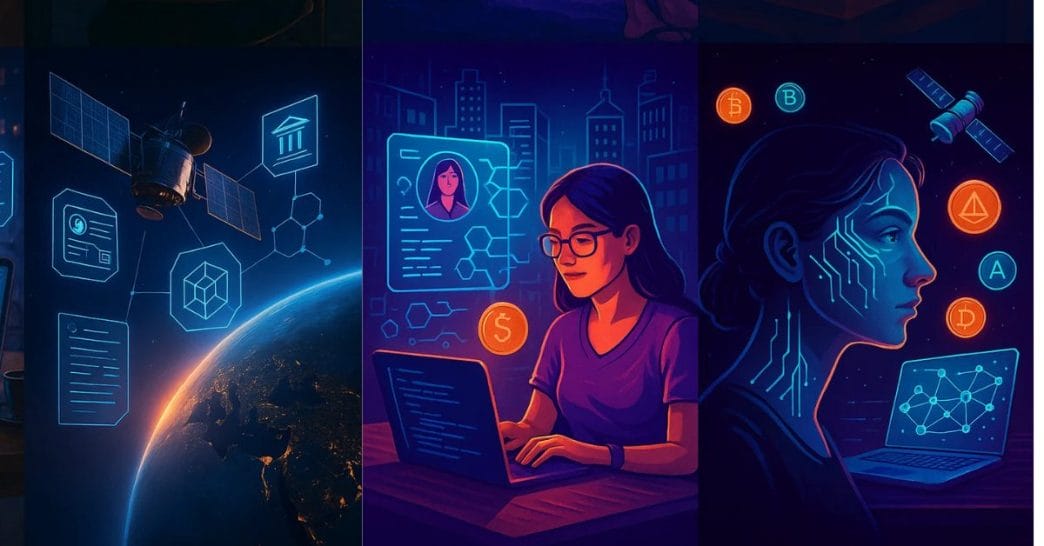The Future Is Nomadic, But Not As We Knew It
Picture this: a software engineer debugging code from a hammock in Bali, an AI ethics consultant attending a virtual board meeting while sipping coffee in a Tallinn café, and a blockchain developer navigating tax forms via a digital ID issued by a country she has never physically visited. They are the Neon Nomads, the new global archetype of remote AI workers powered by crypto, AI copilots, and a lifestyle untethered from geography.
They do not just travel; they drift between digital and physical spaces, between Bali’s beaches, Estonia’s e-residency hubs, and sometimes nowhere at all. This is not just a work-from-anywhere trend. It is a fundamental shift in how we think about work, citizenship, and identity. Let us unpack how the Neon Nomad lifestyle, enabled by cutting-edge technology, is rewriting the rules of the 21st-century workforce.
AI-Augmented Nomadism: More Than Just Remote Work
Gone are the days when remote work meant battling laggy Zoom calls and awkward Wi-Fi spots. Today’s Neon Nomads are augmented by Large Language Models (LLMs) that act as copilots by assisting in coding, content creation, and supporting complex decision-making, though human judgment remains essential.
Imagine an AI assistant that drafts your emails, suggests optimizations to your app’s backend, or synthesizes market data faster than any human team. This is not science fiction, it is the now of AI-enhanced productivity. LLM copilots shrink the cognitive load and multiply output, allowing nomads to work smarter, faster, and more creatively.
Physical goods? No sweat. Emerging drone delivery technologies are beginning to enable faster package transport, with cross-border use still in experimental or early stages. Crypto payments can flow faster than traditional bank transfers and reduce fees, although network and exchange costs may vary. And digital identity solutions like Estonia’s e-residency provide a digital business identity and access to online services, but are not substitutes for physical passports or visas.
These tech layers create a seamless interface between human capability and global opportunity, redefining what it means to be “at work.”
From Brain Drain to Cloud Citizens: The Economic Metamorphosis
Traditionally, countries worried about brain drain, the migration of skilled workers who left their home countries for greener pastures. Neon Nomads change this narrative. They are cloud citizens, untethered from physical borders, choosing digital ecosystems over geographical locations.
This shift is more than personal freedom; it is an economic revolution.
- Governments competing for talent now offer digital residency, crypto-friendly regulations, and innovation hubs accessible globally.
- Workers send remittances digitally, invest across borders, and participate in DAOs (Decentralized Autonomous Organizations), spreading wealth and ideas fluidly.
- Businesses hire globally without visa hassles, tapping into a 24/7 talent pool driven by AI and blockchain verification.
The consequence is that the global economy evolves into a decentralized network where traditional nation-state borders blur. Location becomes a choice and not a limitation. Money and talent flow on digital rails rather than asphalt highways.
Infrastructure for Stateless Living: E-Residency, DAOs, and Satellite Connectivity
What supports this borderless existence?
- E-Residency Programs: Estonia’s pioneering model allows anyone to claim a digital identity, create a company, and access services remotely, a legal foothold without physical presence.
- DAOs: These blockchain-powered organizations enable Neon Nomads to govern, collaborate, and profit transparently without offices or middle management. While promising, DAOs remain experimental and evolving, facing governance challenges such as decision delays, voter participation, and regulatory uncertainty.
- Satellite Internet: High-speed satellite internet significantly improves connectivity in remote areas, though some latency and bandwidth variability remain compared to fiber networks.
Together, these technologies form a robust digital ecosystem supporting stateless, mobile professionals. They are not just “working remotely,” they are living beyond borders.
The Flip Side: Complex Challenges in a Borderless World
As liberating as this lifestyle is, it is tangled with thorny challenges.
- Taxation is a legal labyrinth. Many countries are still developing clear digital nomad tax laws, so this remains a highly uncertain area requiring expert advice on a case-by-case basis. Double taxation, gray areas in residence definitions, and emerging digital tax laws require new strategies and expert advice.
- Law Enforcement and Jurisdiction: Cybersecurity, intellectual property, and contractual disputes demand international cooperation and updated legal frameworks. Who enforces a contract signed in a DAO with members scattered globally? Which laws apply when your office is a virtual space?
- The Human Factor — Belonging: Beyond tech, the Neon Nomad must navigate psychological terrain. Constant mobility can lead to social isolation, cultural dislocation, and the challenge of building meaningful, lasting connections.
New models of community are emerging such as virtual coworking spaces, blockchain-based social groups, and decentralized forums, but the quest for “home” remains a deeply human one.
Navigating the Neon Nomad Revolution: Practical Strategies for Nomads, Businesses, and Policymakers
For Nomads:
- Leverage AI copilots and automation thoughtfully: Integrate AI tools not just to speed up tasks but to offload repetitive work and gain creative insights. Set boundaries to avoid digital burnout. Schedule “AI-free” periods to maintain your own cognitive edge and prevent over-reliance on automation.
- Explore e-residency programs proactively: Research various digital residency options such as Estonia, Georgia, and Portugal to find the best fit for your business and tax situation. Understand the legal nuances including your tax obligations, rights to open bank accounts, and cross-border business compliance to avoid surprises.
- Cultivate intentional routines for mental wellness and community: Design daily rituals that anchor your well-being such as meditation aided by biofeedback tools or regular virtual meetups with fellow nomads. Participate actively in online coworking spaces and DAO communities to build social capital and a sense of belonging despite geographic dispersion.
For Businesses:
- Adapt recruitment and onboarding for a global, borderless workforce: Develop hiring frameworks that account for multiple time zones, asynchronous collaboration, and cultural diversity. Leverage AI-driven tools for skills assessment and onboarding automation to streamline integration regardless of candidate location.
- Implement blockchain-based identity verification: Use decentralized identity solutions to authenticate employees and contractors securely, reducing the risks of fraud and streamlining compliance with Know Your Customer (KYC) and anti-money laundering (AML) regulations. This builds trust and simplifies cross-border payments.
- Embrace DAOs and decentralized collaboration models: Experiment with token-based governance structures and incentive systems to empower remote teams. This can flatten hierarchies, increase transparency, and foster innovation by aligning contributor rewards directly with project success.
For Policymakers:
- Modernize tax and labor laws for cross-border realities: Create clear guidelines for digital nomads and companies regarding income reporting, social security contributions, and dispute resolution. Explore tax treaties and digital tax models that prevent double taxation while ensuring fair contributions.
- Invest in robust digital infrastructure: Expand and subsidize e-residency platforms and satellite internet services to guarantee equitable access for stateless workers. Prioritize cybersecurity and data privacy protections to build public trust in digital identities and online services.
- Develop inclusive, interoperable governance frameworks: Collaborate internationally to harmonize data protection laws, digital signatures, and dispute arbitration mechanisms. Promote open standards to ensure that digital identities, contracts, and DAOs operate seamlessly across jurisdictions.
Neon Nomads embody a new way of working and living, blending AI, blockchain, and global mobility into a seamless experience. They are pioneers of a borderless brain, untethered, tech-augmented, and economically savvy.
For the tech industry and governments alike, this shift is both an opportunity and a challenge. The future workforce will not just clock in remotely; it will live and innovate beyond borders, rewriting citizenship, identity, and productivity in the process.
The question is not whether this future is coming, it is how we will build the infrastructure, policies, and cultures to support it — responsibly, inclusively, and sustainably.















